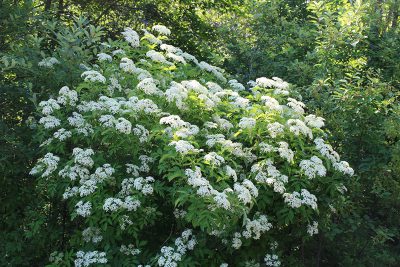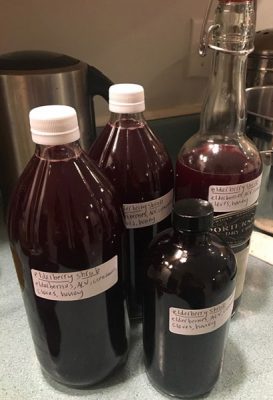Staying Healthy with Native Plants: Elderberry Shrub
by Michelle Smith
 By now, many of us have heard about the wonderful health benefits of elderberries – they are high in antioxidants, vitamins C and B6, and support overall immune health. It has also been shown to reduce the length and severity of the common cold and flu.* Fortunately for us in Maine and the northeast, elderberry (Sambucus nigra subspecies canadensis, formally known as Sambucus canadensis) is also a native plant to the region. Note that there are several species of elderberry whose fruits are edible, including Sambucus nigra subspecies nigra and Sambucus ebulus, which are the closely-related species native to Europe.
By now, many of us have heard about the wonderful health benefits of elderberries – they are high in antioxidants, vitamins C and B6, and support overall immune health. It has also been shown to reduce the length and severity of the common cold and flu.* Fortunately for us in Maine and the northeast, elderberry (Sambucus nigra subspecies canadensis, formally known as Sambucus canadensis) is also a native plant to the region. Note that there are several species of elderberry whose fruits are edible, including Sambucus nigra subspecies nigra and Sambucus ebulus, which are the closely-related species native to Europe.
*These statements have not been evaluated by the FDA. Most of the scientific research on medicinal plants has happened in Germany, through their government funded regulatory Commission E. You can read translations on many species of medicinal plants here. Please do your own research when consuming plants and berries.
 Elderberry can be found in the wild in Maine growing near ditches, roadsides, and wet meadows. They prefer full sun and can grow 8-10 feet tall. Their beautiful white flowers bloom in late spring or early summer and attract bees and other pollinators (and the elder flower is also used for culinary and medicinal purposes). Our native species is also an important host plant for over 40 species of butterflies and moths. The fruits ripen in late August and are relished by migrating songbirds. Elderberry is a hearty, deciduous shrub and a wonderful addition to your yard (seeds can be purchased from the Wild Seed Project online shop). With the rise of elderberry’s popularity over the last few years, it can often be difficult to find the berries for making syrups and shrubs – another reason to plant a few in your yard! Be sure to leave some fruits for the birds.
Elderberry can be found in the wild in Maine growing near ditches, roadsides, and wet meadows. They prefer full sun and can grow 8-10 feet tall. Their beautiful white flowers bloom in late spring or early summer and attract bees and other pollinators (and the elder flower is also used for culinary and medicinal purposes). Our native species is also an important host plant for over 40 species of butterflies and moths. The fruits ripen in late August and are relished by migrating songbirds. Elderberry is a hearty, deciduous shrub and a wonderful addition to your yard (seeds can be purchased from the Wild Seed Project online shop). With the rise of elderberry’s popularity over the last few years, it can often be difficult to find the berries for making syrups and shrubs – another reason to plant a few in your yard! Be sure to leave some fruits for the birds.
Elderberry has long been used in herbal medicine and it’s easy to continue this healthy tradition today. I have taken elderberry daily during the fall and winter months for several years and I now regularly give it to my young children to ward off the germs of preschool and kindergarten! I have always made elderberry syrup, but this past fall I experimented with making elderberry shrub. Shrub is a traditional beverage made with apple cider vinegar, fruit, and honey. Shrubs were very common in before the introduction of refrigeration as a way to preserve the fruits of the summer months.
 Because of the vinegar, elderberry shrub is not as sweet as syrup, but my kids like the tangy bitterness of the shrub. I think it’s also good practice to regularly consume bitter food, as bitters help aid digestion, detoxify our livers and have many other benefits. Making elderberry shrub is also much easier to make than syrup, and you also end up with a larger quantity of liquid (you have to really cook down elderberries to make a good syrup), maximizing the use of your elderberries, which is particularly helpful if you only have a limited amount.
Because of the vinegar, elderberry shrub is not as sweet as syrup, but my kids like the tangy bitterness of the shrub. I think it’s also good practice to regularly consume bitter food, as bitters help aid digestion, detoxify our livers and have many other benefits. Making elderberry shrub is also much easier to make than syrup, and you also end up with a larger quantity of liquid (you have to really cook down elderberries to make a good syrup), maximizing the use of your elderberries, which is particularly helpful if you only have a limited amount.
For my kids, I mix about a teaspoon with water or sparkling water daily. Personally, I like to take it straight as medicine, or I mix it with sparkling water for a refreshing mocktail. If you want to experiment with cocktails, try mixing a splash of elderberry with rum, sparkling water and a squeeze of lime.
Elderberry Shrub Recipe
2 cups fresh/ frozen elderberries*
1-quart apple cider vinegar
1-quart honey**
Other spices that you can experiment with: cinnamon, ginger, cloves
- Remove as many stems as you can from fresh berries. Place berries in a pot and cinnamon stick). Bring to a low simmer and remove from heat source. Once cooled, pour the berries and vinegar in a glass jar and let sit overnight. Some let the berries sit in the vinegar for up to two weeks. Feel free to experiment with how long you let them sit.
- Strain the berries through a cheesecloth (I use cheesecloth in a potato ricer) and squeeze out all the liquid. Add the honey and mix well. I put the shrub back into the apple cider vinegar jars for easy storage. Store in a pantry or cabinet. Make sure to use non-metal lids, as the acid in the vinegar will corrode metal. I have found that shrub lasts the fall and winter months in my pantry, but some people choose to refrigerate it – it’s up to you!
* If you are using dried elderberries, I would use 1 to 1 ¼ cup dried, but experiment with the potency.
** Put in a little honey at a time and taste the shrub. Some people prefer more of a bitter taste, some sweeter – find the right balance you like!
Michelle Smith is a volunteer with Wild Seed Project. She is a freelance communications professional in Portland, Maine, and has managed communications and marketing for several local nonprofits. She enjoys learning about local history, medicinal herbs, native plants, and gardening. Follow her on Instagram @mainebelle.
Native Gardening Blog
After removing disruptive introduced species, try planting these
Join Our Team!
Landscaping in partnership with native ecosystems is good for the planet. It’s good for us too.
Building Biodiverse & Climate-Resilient Habitats
Supporting Ash Protection Collaboration Across Wabanakik

